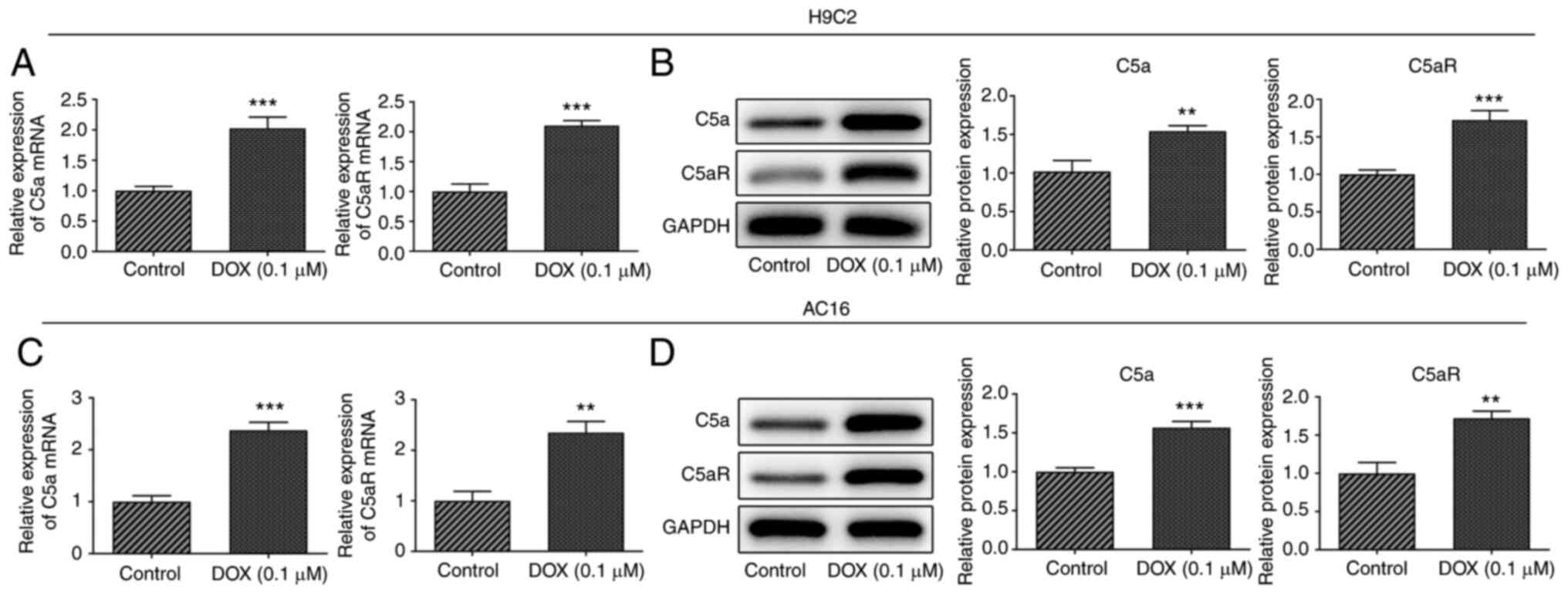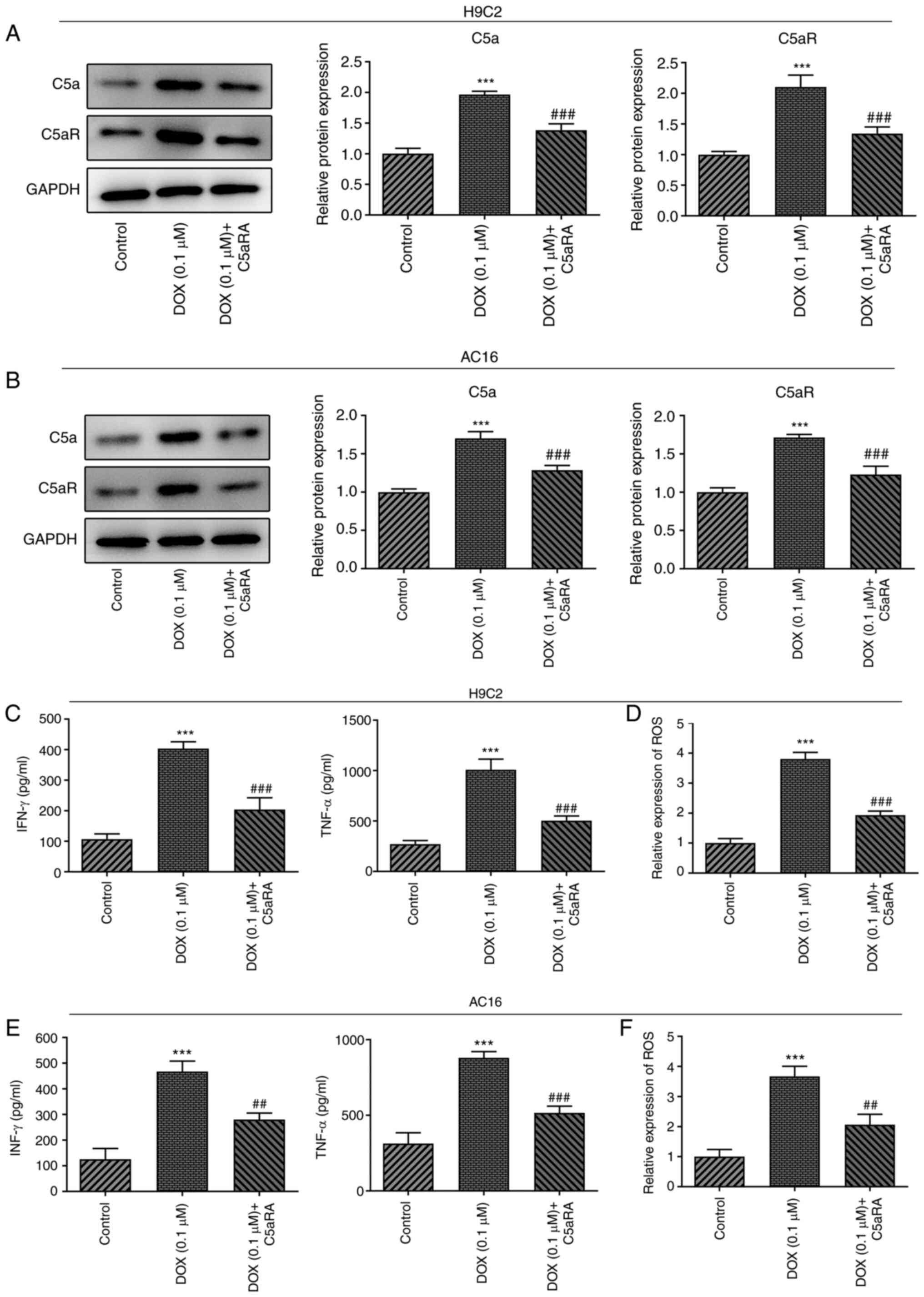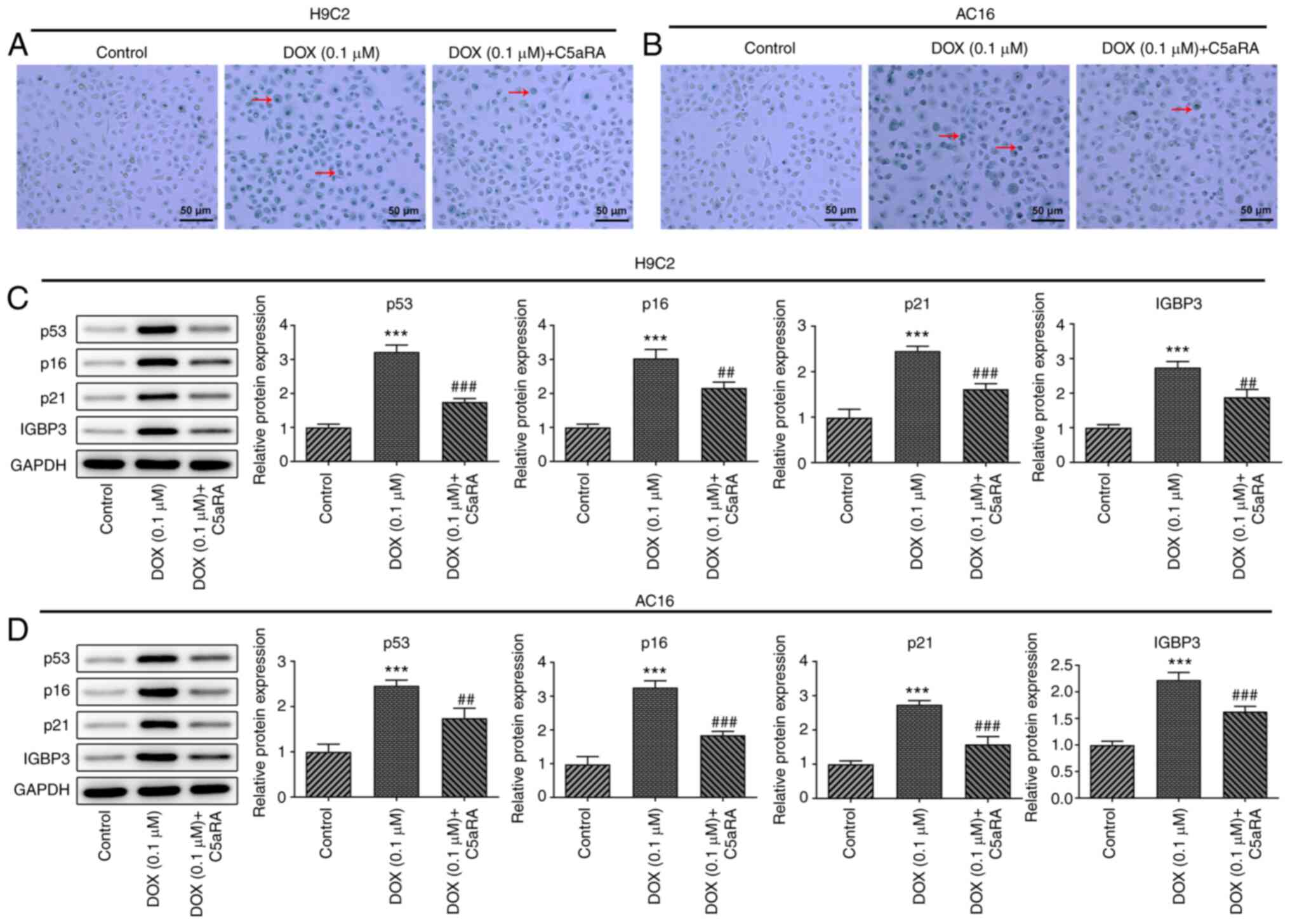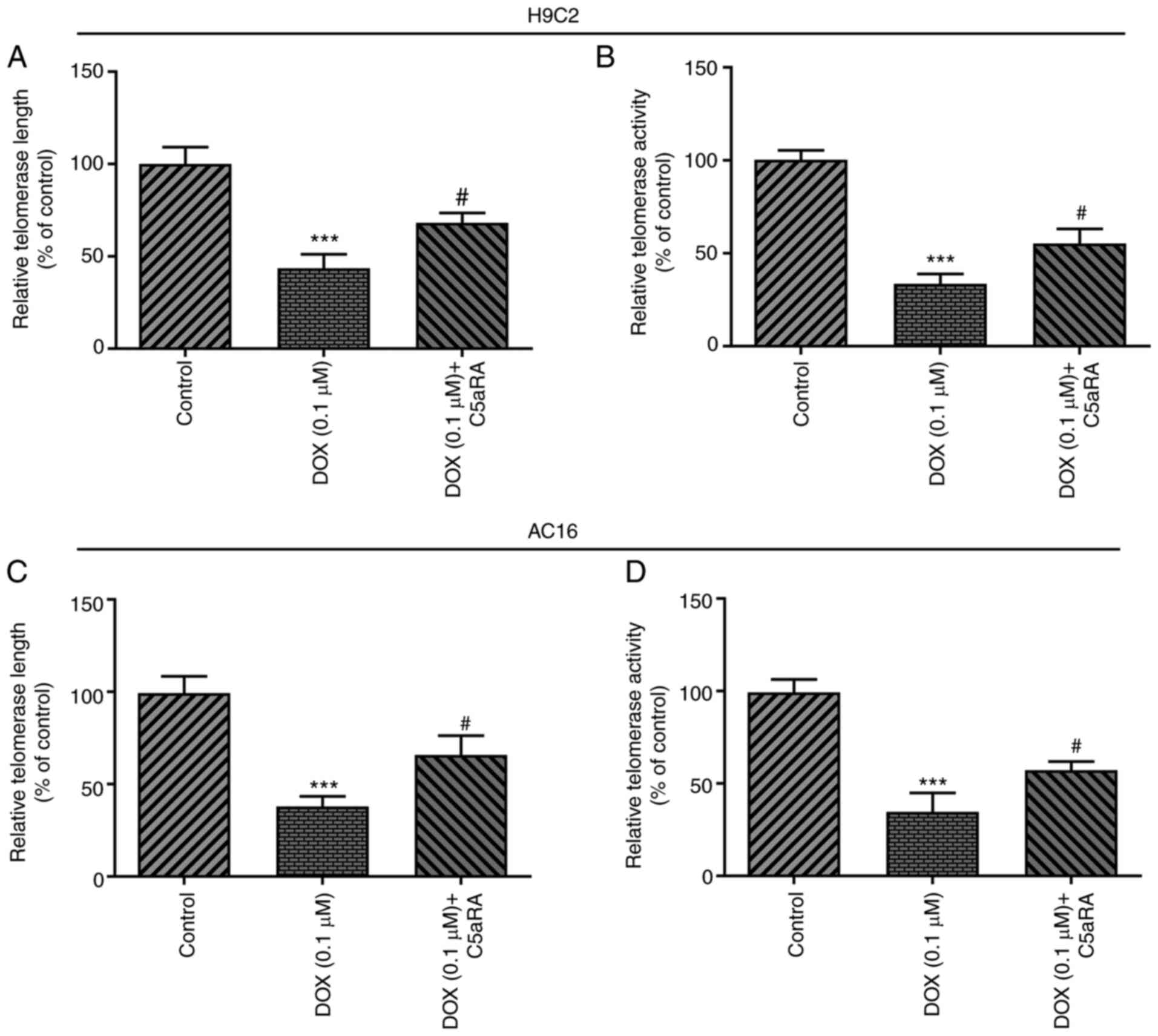|
1
|
Xu T, Ding W, Ji X, Ao X, Liu Y, Yu W and
Wang J: Oxidative stress in cell death and cardiovascular diseases.
Oxid Med Cell Longev. 2019(9030563)2019.PubMed/NCBI View Article : Google Scholar
|
|
2
|
Tang X, Li PH and Chen HZ: Cardiomyocyte
senescence and cellular communications within myocardial
microenvironments. Front Endocrinol (Lausanne).
11(280)2020.PubMed/NCBI View Article : Google Scholar
|
|
3
|
Hernandez-Segura A, Nehme J and Demaria M:
Hallmarks of cellular senescence. Trends Cell Biol. 28:436–453.
2018.PubMed/NCBI View Article : Google Scholar
|
|
4
|
Liu D, Ma Z, Di S, Yang Y, Yang J, Xu L,
Reiter RJ, Qiao S and Yuan J: AMPK/PGC1α activation by melatonin
attenuates acute doxorubicin cardiotoxicity via alleviating
mitochondrial oxidative damage and apoptosis. Free Radic Biol Med.
129:59–72. 2018.PubMed/NCBI View Article : Google Scholar
|
|
5
|
Zhang YW, Shi J, Li YJ and Wei L:
Cardiomyocyte death in doxorubicin-induced cardiotoxicity. Arch
Immunol Ther Exp (Warsz). 57:435–445. 2009.PubMed/NCBI View Article : Google Scholar
|
|
6
|
Singh P, Sharma R, McElhanon K, Allen CD,
Megyesi JK, Beneš H and Singh SP: Sulforaphane protects the heart
from doxorubicin-induced toxicity. Free Radic Biol Med. 86:90–101.
2015.PubMed/NCBI View Article : Google Scholar
|
|
7
|
Maejima Y, Adachi S, Ito H, Hirao K and
Isobe M: Induction of premature senescence in cardiomyocytes by
doxorubicin as a novel mechanism of myocardial damage. Aging Cell.
7:125–136. 2008.PubMed/NCBI View Article : Google Scholar
|
|
8
|
Guo RF and Ward PA: Role of C5a in
inflammatory responses. Annu Rev Immunol. 23:821–852.
2005.PubMed/NCBI View Article : Google Scholar
|
|
9
|
Phieler J, Chung KJ, Chatzigeorgiou A,
Klotzsche-von Ameln A, Garcia-Martin R, Sprott D, Moisidou M,
Tzanavari T, Ludwig B, Baraban E, et al: The complement
anaphylatoxin C5a receptor contributes to obese adipose tissue
inflammation and insulin resistance. J Immunol. 191:4367–4374.
2013.PubMed/NCBI View Article : Google Scholar
|
|
10
|
Jiang Y, Zhao G, Song N, Li P, Chen Y, Guo
Y, Li J, Du L, Jiang S, Guo R, et al: Blockade of the C5a-C5aR axis
alleviates lung damage in hDPP4-transgenic mice infected with
MERS-CoV. Emerg Microbes Infect. 7(77)2018.PubMed/NCBI View Article : Google Scholar
|
|
11
|
Yu S, Wang D, Huang L, Zhang Y, Luo R,
Adah D, Tang Y, Zhao K and Lu B: The complement receptor C5aR2
promotes protein kinase R expression and contributes to NLRP3
inflammasome activation and HMGB1 release from macrophages. J Biol
Chem. 294:8384–8394. 2019.PubMed/NCBI View Article : Google Scholar
|
|
12
|
Merle NS, Grunenwald A, Rajaratnam H,
Gnemmi V, Frimat M, Figueres ML, Knockaert S, Bouzekri S, Charue D,
Noe R, et al: Intravascular hemolysis activates complement via
cell-free heme and heme-loaded microvesicles. JCI Insight.
3(e96910)2018.PubMed/NCBI View Article : Google Scholar
|
|
13
|
Vlaicu SI, Tatomir A, Boodhoo D, Vesa S,
Mircea PA and Rus H: The role of complement system in adipose
tissue-related inflammation. Immunol Res. 64:653–664.
2016.PubMed/NCBI View Article : Google Scholar
|
|
14
|
Martin IV, Bohner A, Boor P, Shagdarsuren
E, Raffetseder U, Lammert F, Floege J, Ostendorf T and Weber SN:
Complement C5a receptors C5L2 and C5aR in renal fibrosis. Am J
Physiol Renal Physiol. 314:F35–F46. 2018.PubMed/NCBI View Article : Google Scholar
|
|
15
|
Brennan FH, Gordon R, Lao HW, Biggins PJ,
Taylor SM, Franklin RJ, Woodruff TM and Ruitenberg MJ: The
Complement receptor C5aR controls acute inflammation and
astrogliosis following spinal cord injury. J Neurosci.
35:6517–6531. 2015.PubMed/NCBI View Article : Google Scholar
|
|
16
|
Leaker BR, Malkov VA, Mogg R, Ruddy MK,
Nicholson GC, Tan AJ, Tribouley C, Chen G, De Lepeleire I, Calder
NA, et al: The nasal mucosal late allergic reaction to grass pollen
involves type 2 inflammation (IL-5 and IL-13), the inflammasome
(IL-1β), and complement. Mucosal Immunol. 10:408–420.
2017.PubMed/NCBI View Article : Google Scholar
|
|
17
|
Yang B, Wang J, Zhao Y, Duan W, Dai C, Han
Z, Wang M, Zhang B, Wei L, Chen Z and Chen D: Attenuating
ischemia/reperfusion injury in rat cardiac transplantation by
intracoronary infusion with siRNA cocktail solution. Biosci Rep.
40(BSR20193937)2020.PubMed/NCBI View Article : Google Scholar
|
|
18
|
Zhang XL, Ji XT, Sun B, Qian LL, Hu XL,
Lou HX and Yuan HQ: Anti-cancer effect of marchantin C via inducing
lung cancer cellular senescence associated with less secretory
phenotype. Biochim Biophys Acta Gen Subj. 1863:1443–1457.
2019.PubMed/NCBI View Article : Google Scholar
|
|
19
|
Livak KJ and Schmittgen TD: Analysis of
relative gene expression data using real-time quantitative PCR and
the 2(-Delta Delta C(T)) method. Methods. 25:402–408.
2001.PubMed/NCBI View Article : Google Scholar
|
|
20
|
Cawthon RM: Telomere length measurement by
a novel monochrome multiplex quantitative PCR method. Nucleic Acids
Res. 37(e21)2009.PubMed/NCBI View Article : Google Scholar
|
|
21
|
Tedone E, Huang E, O'Hara R, Batten K,
Ludlow AT, Lai TP, Arosio B, Mari D, Wright WE and Shay JW:
Telomere length and telomerase activity in T cells are biomarkers
of high-performing centenarians. Aging Cell.
18(e12859)2019.PubMed/NCBI View Article : Google Scholar
|
|
22
|
Gupta SK, Garg A, Bär C, Chatterjee S,
Foinquinos A, Milting H, Streckfuß-Bömeke K, Fiedler J and Thum T:
Quaking inhibits doxorubicin-mediated cardiotoxicity through
regulation of cardiac circular RNA expression. Circ Res.
122:246–254. 2018.PubMed/NCBI View Article : Google Scholar
|
|
23
|
Huang PP, Fu J, Liu LH, Wu KF, Liu HX, Qi
BM, Liu Y and Qi BL: Honokiol antagonizes doxorubicin-induced
cardiomyocyte senescence by inhibiting TXNIP-mediated NLRP3
inflammasome activation. Int J Mol Med. 45:186–194. 2020.PubMed/NCBI View Article : Google Scholar
|
|
24
|
Afshar-Kharghan V: The role of the
complement system in cancer. J Clin Invest. 127:780–789.
2017.PubMed/NCBI View
Article : Google Scholar
|
|
25
|
Ajona D, Ortiz-Espinosa S and Pio R:
Complement anaphylatoxins C3a and C5a: Emerging roles in cancer
progression and treatment. Semin Cell Dev Biol. 85:153–163.
2019.PubMed/NCBI View Article : Google Scholar
|
|
26
|
Sadik CD, Miyabe Y, Sezin T and Luster AD:
The critical role of C5a as an initiator of neutrophil-mediated
autoimmune inflammation of the joint and skin. Semin Immunol.
37:21–29. 2018.PubMed/NCBI View Article : Google Scholar
|
|
27
|
Jayne DRW, Bruchfeld AN, Harper L, Schaier
M, Venning MC, Hamilton P, Burst V, Grundmann F, Jadoul M, Szombati
I, et al: Randomized trial of C5a receptor inhibitor avacopan in
ANCA-associated vasculitis. J Am Soc Nephrol. 28:2756–2767.
2017.PubMed/NCBI View Article : Google Scholar
|
|
28
|
Syed SN, Rau E, Ziegelmann M, Sogkas G,
Brune B and Schmidt RE: C5aR activation in the absence of C5a: A
new disease mechanism of autoimmune hemolytic anemia in mice. Eur J
Immunol. 48:696–704. 2018.PubMed/NCBI View Article : Google Scholar
|
|
29
|
Tang M, Zhang K, Li Y, He QH, Li GQ, Zheng
QY and Zhang KQ: Mesenchymal stem cells alleviate acute kidney
injury by down-regulating C5a/C5aR pathway activation. Int Urol
Nephrol. 50:1545–1553. 2018.PubMed/NCBI View Article : Google Scholar
|
|
30
|
Zhang C, Li Y, Wang C, Wu Y and Du J:
Antagonist of C5aR prevents cardiac remodeling in angiotensin
II-induced hypertension. Am J Hypertens. 27:857–864.
2014.PubMed/NCBI View Article : Google Scholar
|
|
31
|
Minguzzi M, Cetrullo S, D'Adamo S,
Silvestri Y, Flamigni F and Borzi RM: Emerging players at the
intersection of chondrocyte loss of maturational arrest, oxidative
stress, senescence and low-grade inflammation in osteoarthritis.
Oxid Med Cell Longev. 2018(3075293)2018.PubMed/NCBI View Article : Google Scholar
|
|
32
|
Ornish D, Lin J, Chan JM, Epel E, Kemp C,
Weidner G, Marlin R, Frenda SJ, Magbanua MJM, Daubenmier J, et al:
Effect of comprehensive lifestyle changes on telomerase activity
and telomere length in men with biopsy-proven low-risk prostate
cancer: 5-year follow-up of a descriptive pilot study. Lancet
Oncol. 14:1112–1120. 2013.PubMed/NCBI View Article : Google Scholar
|
|
33
|
Louzon M, Coeurdassier M, Gimbert F,
Pauget B and de Vaufleury A: Telomere dynamic in humans and
animals: Review and perspectives in environmental toxicology.
Environ Int. 131(105025)2019.PubMed/NCBI View Article : Google Scholar
|
|
34
|
Victorelli S, Lagnado A, Halim J, Moore W,
Talbot D, Barrett K, Chapman J, Birch J, Ogrodnik M, Meves A, et
al: Senescent human melanocytes drive skin ageing via paracrine
telomere dysfunction. EMBO J. 38(e101982)2019.PubMed/NCBI View Article : Google Scholar
|


















